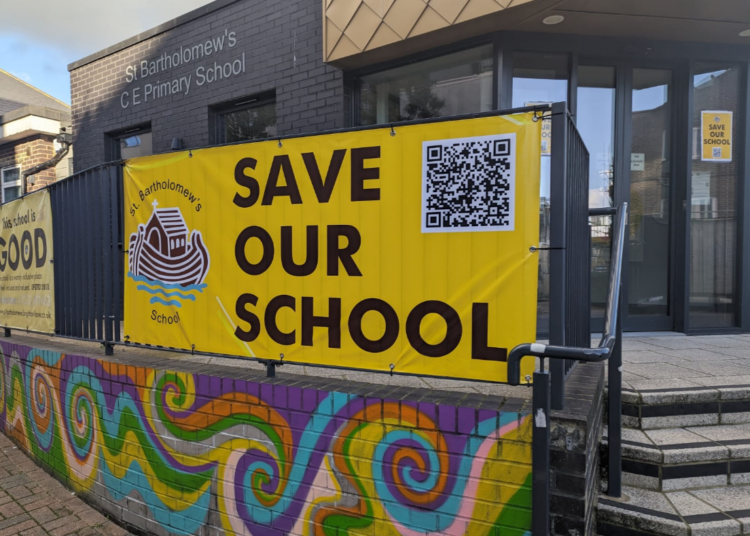Government officials have disagreed with Brighton and Hove City Council’s position that only two-form entry schools can be reduced in size as part of the effort to tackle falling pupil numbers.
The points of difference are set out In a report published earlier this month after an appeal against the decision to close St Bartholomew’s Church of England Primary School by the governors.
The schools adjudicator Tom Brooke and lead schools adjudicator Bryan Slater said that they did not agree with the council’s position that a one-form entry school was the smallest possible size.
The council has been reducing the intake at many of its larger schools since 2019 to try to deal with the reduction in the number of four and five-year-olds.
As a result, intakes have become smaller at several schools including Balfour, Mile Oak, Moulsecoomb and West Blatchington – and at some schools that had previously appealed against reductions, such as Downs Infant School, after admissions dropped.
This year Patcham Infant School, Goldstone Primary School and St Luke’s Primary School have appealed against the council’s decision to reduce their intake by “one form of entry” from September next year.
The adjudicators said: “It (the council) has realised the limitations of relying on this approach which can have the effect of frustrating parental preference if popular schools are reduced in size.
“It has further told us that it considers that reducing the size of primary schools ‘can only take place at schools of two-form entry or more’.
“(It) is not a statement with which we can concur since it implies that the smallest possible size for a primary school is a one-form entry school.
“This is manifestly not the case and it is unfortunate that the council’s approach to the problem it faces is hampered to some extent by this apparent unwillingness to consider more flexible primary school arrangements.”
St Bartholomew’s, in Ann Street, was one of two smallest primary schools in the area when councillors voted in March to close it at the end of this month. They also voted to close St Peter’s Community Primary School, Portslade.
The adjudicators agreed that the closures would help the council to deal with the predicted school places surplus that has been forecast up to 2027.
The council predicted that one in five places would not be needed in the centre of Brighton by 2027 – and one in three places in south Portslade.
Despite this, the adjudicators granted St Bart’s a four-month stay of execution, keeping it open until December, to improve the transition for children as they move to new schools.
An analysis of school places found that most St Bart’s parents were able to find a school place well within a two-mile walk of their home address.
But by late May, 12 families had not sought an alternative place for their child starting in September.
The adjudicators’ report said: “We note at this point, on paper, there are clearly enough alternative primary school places available for children displaced if the school closes.
“We also think it important to bear in mind the high level of needs in the existing population of this school and the undoubted speed with which the proposals had been put forward.”
They noted that one child with an “education, health and care plan” (EHCP) had not secured a school place.
The council said that local primary schools had too many spare places, pushing them into financial deficit, putting jobs at risk as well as jeopardising support for those children in greatest need.
There are currently 2,610 reception year places. The council has forecast that only 1,970 children will require a school place in September next year and just 1,787 in September 2027.
The adjudicators’ report said: “The council has been at pains to impress on us the connection between the issue of school deficit budgets and the precarious nature of the council’s finances as a whole.
“It has provided a statement from its chief finance officer which points out that as a unitary authority, it faces ‘the full range of pressures across council services’ and that draft 2024-25 school budgets show total deficit budgets of over £10 million.
“It reports that school balances in the city have reduced from £8 million in 2021-22 to £0.281 million at the end of the financial year 2023-24.”
The council said that it did not have the money to allow so many schools to go into the red.
The council is liable for school overspending while also grappling with the high cost of adult and children’s social care and homelessness as demand continues to increase.
The adjudicators said: “We accept that the council does have an urgent need to address the surplus capacity in the primary schools in the city on financial grounds.
“However, we cannot but consider that this urgency is at least in part as a result of what appears to have been inaction on its own part in recent years as this problem was developing – both in failing to take action more promptly to address the need to reduce the capacity in schools and to ensure that schools were taking management action to remain within their allocated budgets.
“We do not consider that this urgency should be a reason for making decisions which worsen any adverse impact on very young children, some of whom are known to have multiple vulnerabilities.”











No surprise really the adjudicator reached this decision – think parents and teachers at these schools knew all along that the way Bella Sankey and Jacob Taylor were pushing the closures through was dreadful and they should have handled it differently.
Yes – there might have been failings to address the growing problem previously, but the adjudicator seems pretty clear that the council’s excuse about the financial predicament doesn’t hold up, and that decisions were made which could worsen the “adverse impact on very young children, some of whom are known to have multiple vulnerabilities”.
The fact that the school community made the impacts clear when decisions were made means the councillors can’t say they didn’t know – it was a choice to close the school, but broader than that, it was a choice about how to go about it. Whilst closure might have been the eventual outcome, the choices made by Labour councillors about the way they went about exacerbated distress within the school community.
Politicians often say they have to make “tough decisions” like it’s a badge of honour they are prepared to do for the greater good, and Labour keep saying this locally and now in Westminster. But the handling of the school closures was riddled with flawed decisions, not tough ones – they need to stop mixing up the two and recognise their mistakes, and and learn from the diabolical handling of all this.
Thank you – this is exactly it!
This council is just focussed on what suits them but not the city they are appointed to represent. They have chosen to support a corrupt and lying Royal Mail over protecting the water supply to 140,000 Brighton households. We have suggested some social housing on the Patcham Court Farm site rather than a heavy industrial mega depot threatening the city. This could be in accordance with saving the aquifer area. It would bring homeless families under a roof and bring extra school children in the area. Just how deep does the corruption go in this council?
The councils far to busy being corrupt to care about the decline in schools. Unelected officails go out of there way to make your life miserable providing theres some monetary gain. The real issues the average Brightons face just aren’t paying
Please stop using photos of Rudyard Kipling PS in your articles about reduction of PAN places/school closures. Its utterly dishonest and hurtful to the schools reputation.